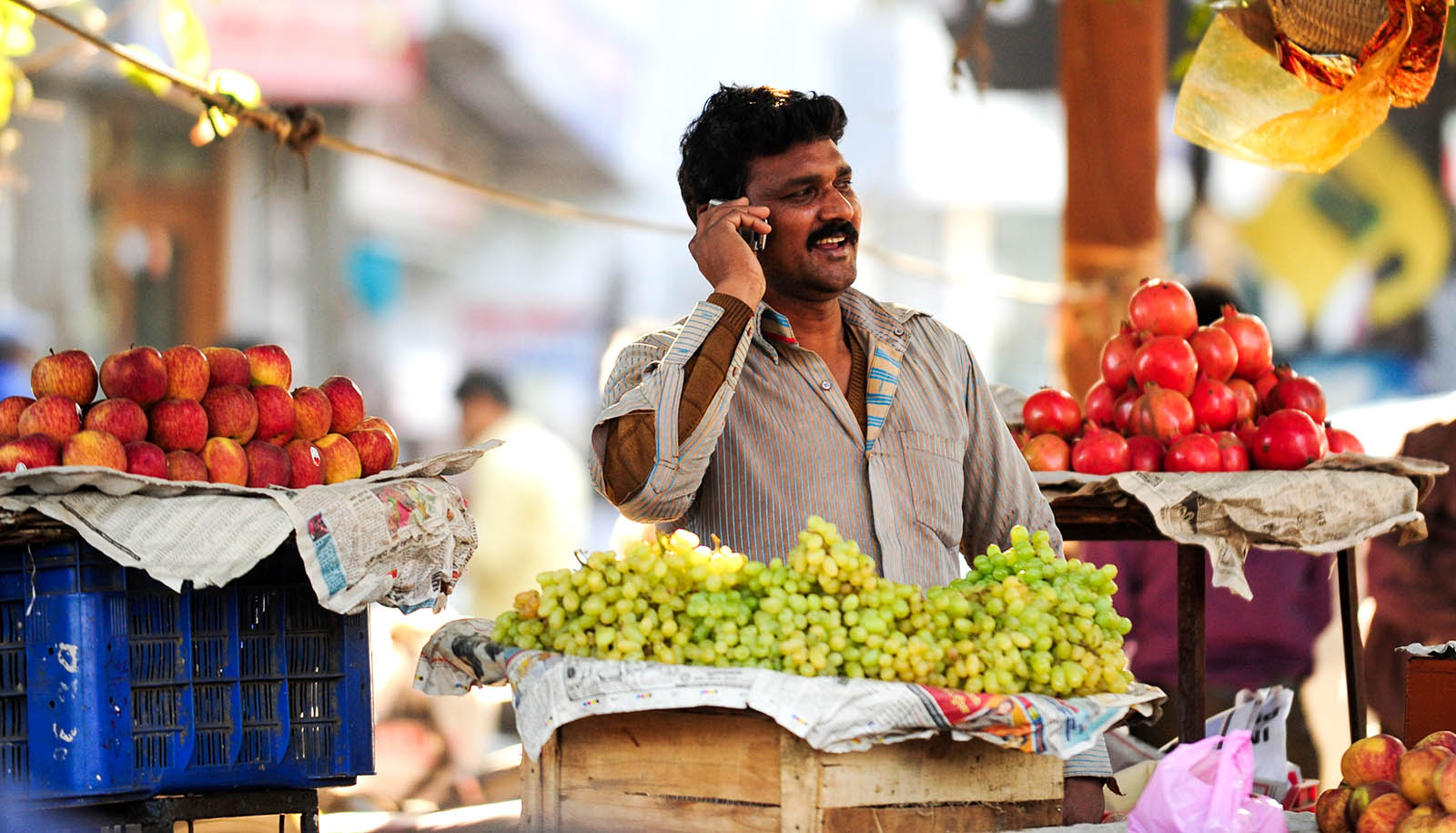How Technology Is Delivering Better Access to Financial Services

An fruit vendor in India speaks on his mobile phone. Small businesses can greatly benefit from digital financial services, particularly in countries where account owners are more likely to have mobile phones than debit cards.
Photo: Sanjay Kanojia/AFP/Getty Images
Digital technology is spurring financial inclusion around the world, enabling millions more people and businesses to join the global economy for the first time. Yet there is much more work to do.
That’s the key message from the World Bank’s new Global Findex database, a groundbreaking portrait of how people in more than 140 economies use cards, mobile phones and the Internet to make payments and manage money.
Access to financial services is critical for global development, as it makes it easier to invest in health, education and business. Digital technologies offer a powerful way to boost financial access.
As the fintech revolution continues to unfold, digitally enabled financial services are dramatically expanding the ways in which people transact beyond traditional banking. They are also changing the ways incumbent banks do banking, as they are themselves increasingly digitizing traditional channels.
The key features of digital financial services—ease of use such as through mobile phones, scalability, and customer-centric design—promote affordability and convenience. This, in turn, underpins their adoption and promotes financial access and inclusion.
Digitally enabled financial services facilitate day-to-day living, help families and businesses plan for everything from long-term goals to unexpected emergencies, and contribute to prosperity and resilience.
Financial Inclusion Rising Globally
The Global Findex database—the methodology can be found here—shows that since 2011, 1.2 billion adults (aged 15 and above) have opened an account. What is remarkable is that 515 million did so over the last three years. As a result, an astounding 69 percent of adults now have digital channels for moving money, saving, and managing financial risks.
We see that, for the first time, a majority of adults around the world report using digital payments: 52 percent of adults—or 76 percent of account owners—make or receive digital payments. This represents major growth: Since 2014, the number of adults making or receiving digital payments rose 10 percentage points or more in countries such as China, Indonesia, Kenya, Malaysia, the Russian Federation, Thailand and Turkey.
Exhibit 1: Percentage of Adults Making or Receiving Digital Payments
More Needs To Be Done
Yet, there is room for much more growth. The data points to an array of opportunities to expand digital offerings in developing countries. Digital technology access is high among account owners: Globally, almost 90 percent of people have their own mobile phone, while 58 percent have access to the Internet in addition to owning a mobile phone.
One key bottleneck is that adults who do own a phone and have Internet frequently lack attractive choices for using these technologies to make transactions. Take utility bills. Many people reading this might not remember the last time they wrote a check or withdrew cash to pay for water or electricity expenses; they use automatic payments instead. That option is not always available in poorer countries.
Globally, one billion adults with an account still pay utility bills in cash. And many of these adults have access to digital technology that could provide better options. In Vietnam, for example, nearly 70 percent of account owners pay utility bills in cash only—even though three-quarters of them have a mobile phone as well as the Internet. If utility providers offered good quality, affordable digital alternatives, their customers might move their cash payments into accounts, improving efficiency on both sides.
Exhibit 2: A Billion Adults Who Have an Account Still Pay Utility Bills in Cash (Adults with an Account Paying Utility Bills in the Past Year in Cash Only, 2017)
Merchants and small businesses can greatly benefit from digital financial services, particularly in countries where account owners are more likely to have mobile phones than debit cards. In India, 240 million adults have a mobile phone but do not use their bank account. Inactive accounts are often due to a combination of inconvenient access, limited financial literacy of the users, and a mismatch between customer demand and product design. Expanding accessibility of financial services by enabling mobile phone transactions coupled with expanding acceptance networks, leveraging retail outlets, can help to increase use.
Past Success Stories Offer Lessons for the Future
How do we learn from our experience to do more? We can draw on the lessons from the success stories we have witnessed around the world. Consider the following examples from China, Brazil and several countries in Africa.
The ability to leverage technology is driving use in China and other markets globally. The Global Findex database confirms China’s emergence as a fintech innovator, in large part due to highly scalable e-commerce payment solutions designed by the private sector. Buoyed by the rise of secure, affordable, and convenient nonbank payment providers, which leverage the existing penetration of formal bank accounts, the share of adults in China making digital payments shot from 44 percent in 2014 to 68 percent in 2017. Banks in China have also increasingly digitized their processes to drive adoption and use.
The example of Brazil demonstrates the importance of cost control. In Brazil, Internet payments are low but growing as new digital financial services entrants mount a challenge to the small group of incumbents that dominate retail banking. Since 2014, the share of account owners using the Internet to pay bills or buy things has nearly doubled. The lower costs of digital financial services could have special appeal in Brazil, where unbanked adults are twice as likely as the global average to say financial services are too expensive.
Other examples from Africa illustrate how profitability can be achieved at scale. Payment models with the ability to deliver low-value payments at an affordable cost tend to drive a high volume of transactions, allowing them to reach scale in many emerging markets. Sub-Saharan Africa claims all 10 economies worldwide where mobile money ownership is higher than financial institution account ownership: Burkina Faso, Chad, Côte d’Ivoire, Gabon, Kenya, Mali, Senegal, Tanzania, Uganda, and Zimbabwe.
Reflecting on high mobile money penetration, 97 percent of account owners in Kenya use digital payments, which is as high as the share in high-income economies. M-Pesa’s storied and strong growth is often attributed in part to demand for domestic remittances in Kenya. This shows us that the M-Pesa product addressed a specific customer need—providing utility in helping people efficiently manage a part of their financial lives. Tailoring financial products to specific customer needs is key to achieving scale. Moreover, partnerships can expand accessibility. For example, M-Pesa recently launched a partnership with PayPal to enable Kenyan M-Pesa’s 27.8 million customers to transact with PayPal’s 227 million users around the world by combining mobile money providers and Internet payments solutions.
Remittances are also a prominent example of how fintech can provide lower-cost options. A study by the Global System for Mobile Communications Association found that remittances sent between mobile networks in Africa were half the cost of traditional remittance services. Another study by Xoom had a similar finding, showing that digital remittances cost, on average, just 3.93 percent of the amount sent compared with World Bank data demonstrating that the average cost of sending a remittance is 7.45 percent across all remittance types. Digital remittances are well on the way to achieving the UN Sustainable Development Goal of lowering remittances costs to less than 3 percent.
A Bright Future for Digitally Enabled Financial Services
Such services can serve as an entry point into the world’s increasingly digital economy, creating greater access to information, transparency, and triggering growth through more efficient and targeted customer engagement in developing countries. Building from the insights of the new Global Findex, leaders in the public and private sectors must begin to work together in new ways and contexts to ensure we achieve our collective vision of universal financial access and improved financial health for all.
This piece first appeared on the World Economic Forum Agenda.





